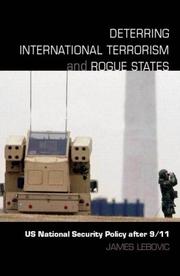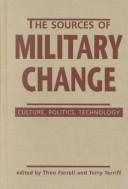| Listing 1 - 10 of 11 | << page >> |
Sort by
|
Book
ISBN: 0190937262 0190935332 0190935340 Year: 2019 Publisher: New York, NY : Oxford University Press,
Abstract | Keywords | Export | Availability | Bookmark
 Loading...
Loading...Choose an application
- Reference Manager
- EndNote
- RefWorks (Direct export to RefWorks)
The US wars in Vietnam (1965-1973), Iraq (2003-2011), and Afghanistan (2001-present) stand out for their endurance, resource investment, human cost, and common decisional failings. Despite its planning, the US failed to meet its early objectives in every one of these conflicts. A profound myopia at four stages of intervention helps explain why the US fought; chose to increase, decrease, or end its involvement in the conflicts; encountered a progressively reduced set of options; and settled for suboptimal results. US leaders were effectively planning to fail, whatever their hopes and thoughts at the time. American decision makers struggled less than they should have when conditions permitted good choices, and then struggled more than could matter when conditions left them with only bad choices.
National security --- Afghan War, 2001 --- -Vietnam War, 1961-1975. --- Iraq War, 2003-2011. --- Decision making --- United States --- Military policy --- History, Military --- Operation Enduring Freedom, 2001 --- -War on Terrorism, 2001-2009 --- National security policy --- NSP (National security policy) --- Security policy, National --- Economic policy --- International relations --- Anglo-American Invasion of Iraq, 2003-2011 --- Dawn, Operation New, 2010-2011 --- Gulf War II, 2003-2011 --- Iraqi Freedom, Operation, 2003-2010 --- New Dawn, Operation, 2010-2011 --- Operation Iraqi Freedom, 2003-2010 --- Operation New Dawn, 2010-2011 --- Operation Telic, 2003-2011 --- Persian Gulf War, 2003-2011 --- Telic, Operation, 2003-2011 --- War on Terrorism, 2001-2009 --- Vietnam Conflict, 1961-1975 --- Vietnamese Conflict, 1961-1975 --- Vietnamese War, 1961-1975 --- Government policy --- U.S.A. --- Jungtinės Amerikos valstybės --- Soedinennye Shtaty Si︠e︡vernoĭ Ameriki --- Soedinennye Shtaty Severnoĭ Ameriki --- Si︠e︡vero-Amerikanskīe Soedinennye Shtaty --- Severo-Amerikanskie Soedinennye Shtaty --- Zlucheni Derz︠h︡avy --- USA --- US --- Arhab --- Ar. ha-B. --- Artsot ha-Berit --- ولايات المتحدة الامريكية --- Wilāyāt al-Muttaḥidah al-Amirīkīyah --- ABSh --- Amerika Birlăshmish Shtatlary --- ABŞ --- Amerika Birlăşmi Ştatları --- Forente stater --- Spojené staty americké --- Severo-Amerikanskie Shtaty --- Sjedinjene Američke Države --- Zʹi︠e︡dnani Derz︠h︡avy Ameryky --- Amerikai Egyesült Államok --- Yhdysvallat --- Verenigde Staten --- Egyesült Államok --- Hiwsisayin Amerikayi Miatsʻeal Tērutʻiwnkʻ --- Estados Unidos de América --- United States of America --- Fareyniḳṭe Shṭaṭn --- Artzois Ha'bris --- Estados Unidos da América do Norte --- SShA --- Soedinennye Shtaty Ameriki --- VSA --- États-Unis d'Amérique --- Vereinigte Staaten von Amerika --- Stati Uniti d'America --- Estados Unidos --- EE.UU. --- Stany Zjednoczone --- ĒPA --- Amerika Qūrama Shtattary --- Amerika Qŭshma Shtatlari --- SAD --- Saharat ʻAmērikā --- Hēnomenai Politeiai Amerikēs --- ZSA --- Mei-kuo --- Meiguo --- Mei guo --- ZDA --- Združene države Amerike --- U.S. --- America (Republic) --- Amirika Carékat --- Verenigde State van Amerika --- VS --- ولايات المتحدة --- Wilāyāt al-Muttaḥidah --- ولايات المتّحدة الأمريكيّة --- Wilāyāt al-Muttaḥidah al-Amrīkīyah --- Estatos Unitos --- Estatos Unitos d'America --- Ètats-Unis d'Amèrica --- Estaos Xuníos d'América --- Estaos Xuníos --- Tetã peteĩ reko Amérikagua --- Istadus Unidus --- Amerika Birlăşmiş Ştatları --- Amerika ka Kelenyalen Jamanaw --- Bí-kok --- Amerika Qushma Shtattary --- AQSh --- Злучаныя Штаты Амерыкі --- Zluchanyi︠a︡ Shtaty Ameryki --- Yunaeted Stet blong Amerika --- Yunaeted Stet --- Vaeinigte Staatn --- Vaeinigte Staatn vo Amerika --- Stadoù-Unanet Amerika --- Sŭedineni amerikanski shtati --- САЩ --- SASht --- Съединените щати --- Sŭedinenite shtati --- Америка (Republic) --- Amerika (Republic) --- Estats Units d'Amèrica --- Америкӑри Пӗрлешӳллӗ Штатсем --- Amerikări Pĕrleshu̇llĕ Shtatsem --- Stati Uniti --- SUA (Stati Uniti d'America) --- Unol Daleithiau America --- Unol Daleithiau --- Amerikas Forenede Stater --- Vereinigte Staaten --- Wááshindoon Bikéyah Ałhidadiidzooígíí --- Zjadnośone staty Ameriki --- Ameerika Ühendriigid --- Ηνωμένες Πολιτείες της Αμερικής --- Hēnōmenes Politeies tēs Amerikēs --- Η.Π.Α. --- Ē.P.A. --- Usono --- Unuiĝintaj Ŝtatoj de Ameriko --- Американь Вейтьсэндявкс Штаттнэ --- Amerikanʹ Veĭtʹsėndi︠a︡vks Shtattnė --- Ameriketako Estatu Batuak --- Feriene Steaten --- Feriene Steaten fan Amearika --- FS --- Stâts Unîts di Americhe --- Stâts Unîts --- Stáit Aontaithe Mheiriceá --- Steatyn Unnaneysit America --- Steatyn Unnaneysit --- S.U.A. --- Na Stàitean Aonaichte --- NSA --- Mî-koet --- 미국 --- Miguk --- Amerikayi Miatsʻyal Nahangner --- Miatsʻyal Nahangner --- Американь Вейтьсэндявкс Штаттнэ --- Spojené obce severoamerické --- -Operation Enduring Freedom, 2001 --- Afghan War, 2001-2021. --- Vietnam War, 1961-1975. --- États-Unis --- É.-U. --- ÉU
Book
ISBN: 1421411032 9781421411033 9781421411026 1421411024 Year: 2013 Publisher: Baltimore Johns Hopkins University Press
Abstract | Keywords | Export | Availability | Bookmark
 Loading...
Loading...Choose an application
- Reference Manager
- EndNote
- RefWorks (Direct export to RefWorks)
Arms control --- Presidents --- Nuclear arms control --- Security, International --- Arms race --- Disarmament --- Military readiness --- Nuclear weapons control --- Nuclear weapons --- Decision making. --- History --- United States --- Military policy. --- Defenses. --- 20th century --- Decision making --- Military policy --- Defenses
Book
ISBN: 0197680801 0197680887 0197680895 Year: 2023 Publisher: New York, New York ; Oxford, England : Oxford University Press,
Abstract | Keywords | Export | Availability | Bookmark
 Loading...
Loading...Choose an application
- Reference Manager
- EndNote
- RefWorks (Direct export to RefWorks)
In this book, James H. Lebovic argues that the policy approach to maintain nuclear superiority did not make sense during the Cold War and makes even less sense now. As he shows, the idea that nuclear superiority is an imperative still serves as the foundation for too much strategic policy in an era where utility of such weapons is highly questionable. Moreover, continuing to rely on them as coercive tools rests on deficient logic and is dangerous. Not only explaining why we remain stuck with a nuclear stance that is largely irrelevant to the era, this book also offers a way out of the type of thinking that keeps such policies in place.
Nuclear warfare. --- Deterrence (Strategy). --- Military policy --- Psychology, Military --- Strategy --- First strike (Nuclear strategy) --- Nuclear crisis stability --- Atomic warfare --- CBR warfare --- Nuclear strategy --- Nuclear war --- Thermonuclear warfare --- War --- Nuclear crisis control --- Nuclear weapons --- United States --- Foreign relations
Book
ISBN: 9780190935320 0190935324 Year: 2019 Publisher: New York, NY: Oxford university press,
Abstract | Keywords | Export | Availability | Bookmark
 Loading...
Loading...Choose an application
- Reference Manager
- EndNote
- RefWorks (Direct export to RefWorks)
National security --- Afghan War, 2001 --- -United States --- Vietnam War, 1961-1975 --- Iraq War, 2003-2011 --- United States
Book
ISBN: 9780801894725 Year: 2010 Publisher: Baltimore Johns Hopkins University Press
Abstract | Keywords | Export | Availability | Bookmark
 Loading...
Loading...Choose an application
- Reference Manager
- EndNote
- RefWorks (Direct export to RefWorks)

ISBN: 9780415771443 Year: 2007 Publisher: New York London Routledge
Abstract | Keywords | Export | Availability | Bookmark
 Loading...
Loading...Choose an application
- Reference Manager
- EndNote
- RefWorks (Direct export to RefWorks)
Book
ISBN: 9780231880619 Year: 1990 Publisher: New York, NY
Abstract | Keywords | Export | Availability | Bookmark
 Loading...
Loading...Choose an application
- Reference Manager
- EndNote
- RefWorks (Direct export to RefWorks)
Multi
ISBN: 9780231880619 9780231908122 Year: 1990 Publisher: New York, N.Y. Columbia University Press
Abstract | Keywords | Export | Availability | Bookmark
 Loading...
Loading...Choose an application
- Reference Manager
- EndNote
- RefWorks (Direct export to RefWorks)
Book
ISBN: 9780197680872 Year: 2023 Publisher: New York : Oxford University Press,
Abstract | Keywords | Export | Availability | Bookmark
 Loading...
Loading...Choose an application
- Reference Manager
- EndNote
- RefWorks (Direct export to RefWorks)
NUCLEAR WARFARE--USA --- DETERRENCE (STRATEGY) --- USA--FOREIGN RELATIONS


ISBN: 1588261794 9781588261793 1555879756 9781555879754 Year: 2022 Publisher: Boulder
Abstract | Keywords | Export | Availability | Bookmark
 Loading...
Loading...Choose an application
- Reference Manager
- EndNote
- RefWorks (Direct export to RefWorks)
In varying circumstances, military organizations around the world are undergoing major restructuring. This book explores why, and how, militaries change. The authors focus on a complex of three influencing factors—cultural norms, politics, and new technology—offering a historical perspective of more than a century. Their analyses range from developing states to Russia, Britain, the U.S., and NATO. Throughout, they reveal the manifold interactions between state and military, and also within both, as primary driving forces of change.
Military art and science --- Armed Forces --- Civil-military relations --- Sociology, Military --- Military sociology --- Armies --- Peace --- War --- War and society --- Military and civilian power --- Military-civil relations --- Executive power --- Military government --- Armed Services --- Military, The --- Disarmament --- Fighting --- Military power --- Military science --- Warfare --- Warfare, Primitive --- Naval art and science --- History --- Technological innovations --- Militærvidenskab --- Våbenteknologi --- Udvikling
| Listing 1 - 10 of 11 | << page >> |
Sort by
|

 Search
Search Feedback
Feedback About UniCat
About UniCat  Help
Help News
News